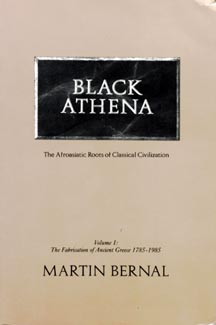| WORLD STUDIES BOOK LIST FOR ANCIENT CIVILIZATIONS |
 |
| WORLD STUDIES BOOK LIST FOR ANCIENT CIVILIZATIONS |
 |
| Textbooks often present ancient civilizations as eternal truths of the past, neglecting the present acts of interpretation that construct histories. Most of the titles in this list are rigorous but somewhat unconventional histories challenging the prevalent versions; several are noteworthy for their sheer audacity in scope and vision. Each challenges readers to think not only about "the facts" of history, but also about the sifting and interpreting processes with which all historians work. As always, see the bibliographies for each work to delve deeper into the various sub-topics. |
| Martin Bernal, Black
Athena: The Afroasiatic Roots of Classical Civilization.
Volume 1: The Fabrication of Ancient Greece 1785-1985
(1987) The first in a proposed series of four volumes taking a new look at the roots of Western Civilization, Bernal's overall thesis, as the title suggests, is that classical Greek civilization has deep roots in Afroasiatic cultures--primarily Egyptian and Semitic. But there is another story he tells simultaneously--and this is the main reason for the book's notoriety--that white supremacist European historians during the 18th and 19th centuries systematically "cleansed" ancient Greek history of all its Afroasiatic influences.
Joseph Campbell, The Hero With A Thousand Faces (1949/1968) This best-known work by the maverick mythologist tells the archetypal story of the hero's journey and transformation. Drawing upon virtually all of the world's religions and mythologies, Campbell traces the hero's departure, initiation, and return, before synthesizing the archetype in terms of its emanations, virgin birth, transformations, and dissolutions. Notable for Campbell's sensitive and reverent comparative method.
James G. Frazer, The Golden Bough: The Roots of Religion and Folklore (1890/1981) Comprehensive study of religion in ancient civilizations, discussing forms of paganism and pantheism, especially in Europe, with surprising revelations on the origins of some prevalent Christian rituals.
Tikva Frymer-Kensky, In the Wake of the Goddesses: Women, Culture and the Biblical Transformation (1992) Argues that the recent trend callings for a return to ancient goddess-based religion as an antidote to centuries of misogyny in Western religions has distorted the legacy of ancient polytheism. Frymer-Kensky reasons that, although polytheistic religions did respect women's roles as important, the rigid separation of male and female kept women in a subordinate role. Also challenges biblical exegetic orthodoxy on sexuality.
Eva C. Keuls, The Reign of the Phallus: Sexual Politics in Ancient Athens (1985) Using a wealth of pictorial and textural sources, Keul argues that the culture of ancient Athens was more male-dominated, sexually polarized, and repressive of women than any other culture in Western history.
Albert B. Lord, The Singer of Tales (1960) In a groundbreaking study in ancient epics, Lord formulates a theory of oral performance by studying 20th century epic singers in Yugoslavia, and then applies this to develop an understanding of the Homeric epics.
Lewis Mumford, The City in History: Its Origins, Its Transformations, and Its Prospects (1961) Traces the development of cities from Egypt and Mesopotamia to Greece, Rome, and Medieval Europe, and the modern world, arguing that healthy cities work best in a symbiotic relationship in their biosphere.
James B. Pritchard, The Ancient Near East (1958) Handy sourcebook with maps, primary texts, and pictures on Egypt, Sumeria, Mesopotamia, and Palestine.
Kamal Salibi, Secrets of the Bible People (1988) Argues that the Old Testament's true setting was not in Palestine, but in Western Arabia.
Immanuel Velikovsky, Worlds In Collision (1950) Citing corroborating evidence from myths and legends of many cultures, Velikovsky contends that ancient history can best be understood in terms of cataclysmic changes in the earth and solar system, attributing Biblical miracles and events to phenomena like comets or volcanoes. Many of his claims, initially derided by historians, theologians, and geologists as absurd, have since been shown to be highly likely after recent developments in the physical sciences, notably through paradigm shifts in astronomy and plate techtonics. |